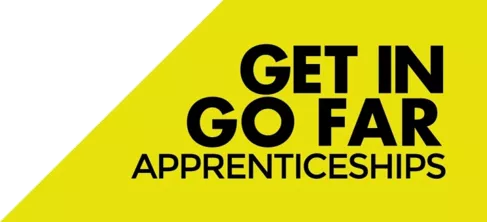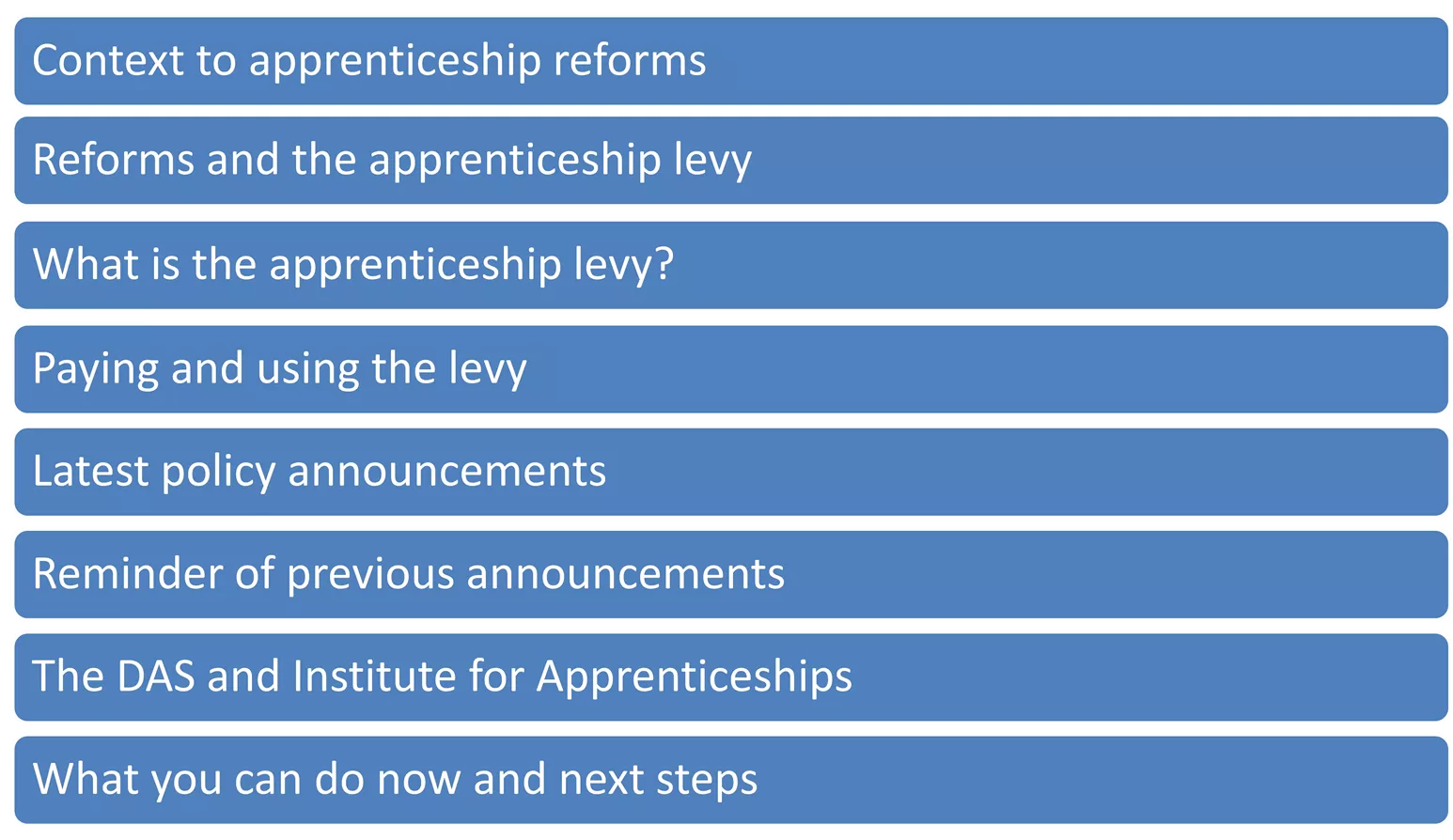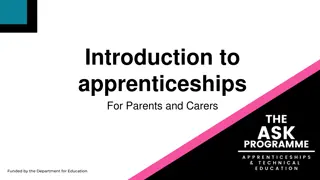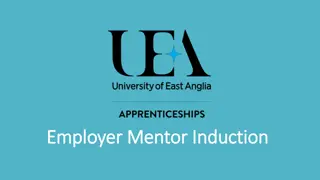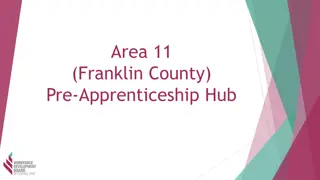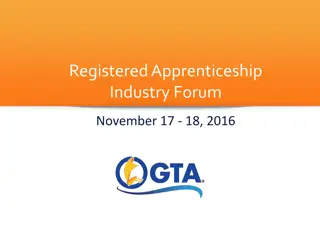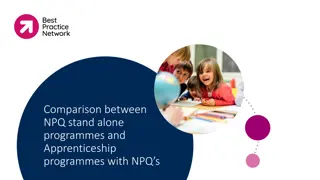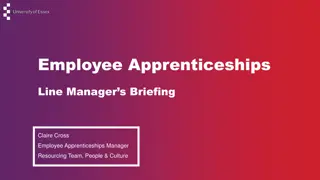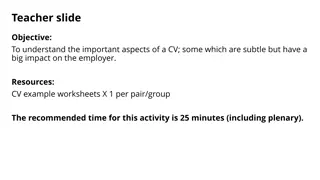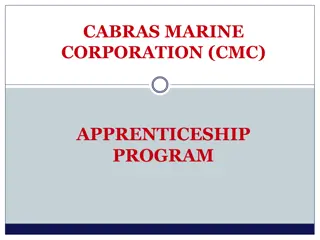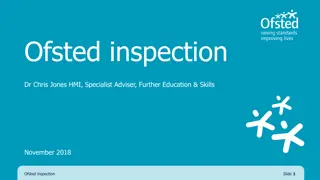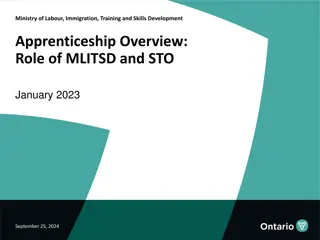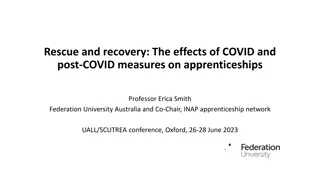Government's Initiatives to Enhance Apprenticeship Programs
The UK government is dedicated to boosting the quantity and quality of apprenticeship programs to address economic challenges and enhance workforce skills. Initiatives include increasing apprenticeship starts, enhancing training quality, and ensuring equal legal protection for apprenticeships. The goal is to improve labor market outcomes and foster economic growth through skilled apprenticeships.
Download Presentation

Please find below an Image/Link to download the presentation.
The content on the website is provided AS IS for your information and personal use only. It may not be sold, licensed, or shared on other websites without obtaining consent from the author. Download presentation by click this link. If you encounter any issues during the download, it is possible that the publisher has removed the file from their server.
E N D
Presentation Transcript
Content Context to apprenticeship reforms Reforms and the apprenticeship levy What is the apprenticeship levy? Paying and using the levy Latest policy announcements Reminder of previous announcements The DAS and Institute for Apprenticeships What you can do now and next steps 2
Action is needed to address current economic trends UK productivity lags behind other developed economies and employers are investing less in training and employers are investing less in training Number of employees who worked fewer hours than usual because they attended a training course away from their workplace 200,000 180,000 Meanwhile relative social mobility has stagnated or declined over recent decades 160,000 140,000 120,000 100,000 80,000 60,000 The UK has low levels of intergenerational social mobility compared to some other developed countries 40,000 20,000 0 1992 1993 1994 1995 1996 1997 1998 1999 2000 2001 2002 2003 2004 2005 2006 2007 2008 2009 2010 2011 2012 2013 2014 3 3
Apprenticeships contribute to addressing these challenges That s why the government is committed to significantly increasing the quantity and quality of apprenticeships in England and achieving 3 million starts by 2020. Benefits Apprentices complete their apprenticeship with highly marketable skills that make it more likely for them to remain employed, including with the same employer. Employers experience tangible improvements to their product or service as a result of apprenticeships. Apprenticeships create real benefits for the taxpayer and the wider economy and contribute to the Government s overall goal of improving labour market outcomes. 4
But the programme could be bigger and better Individual apprenticeships provide good returns, but there is an insufficient number of apprenticeship opportunities to meet demand from individuals, and skills gaps remain in the economy. Whilst the vast majority of apprenticeships provide high quality training, feedback from employers shows that this is not always the case. We need to continue to drive up the quality of apprenticeship training and ensure that anyone completing an apprenticeship is fully competent in their occupation. Ambitious Government reforms: Employers at the heart of designing new Apprenticeships Standards to replace apprenticeship frameworks by 2020. New Institute for Apprenticeships led by employers to oversee standards and ensure quality and rigour Apprenticeships given equal legal protection to degrees Apprenticeship target for public sector bodies duty for 2.3% of workforce to be apprentices will grow opportunities Secondary Class 1 NICs abolished for apprentices under the age of 25 since April 2016 All underpinned by changes to how apprenticeships are paid for. New apprenticeship levy paid by 2% of employers will fund expansion. Digital Apprenticeship Service will enable employers to directly manage their apprenticeship programmes and purchase training. 5
Apprenticeship funding in England from May 2017: How the funding changes, including the levy, work
What is the apprenticeship levy and who pays it? Starts on 6 April 2017, at a rate of 0.5% of pay bill, paid through PAYE Applies to all UK employers in all sectors 15,000 allowance is not a cash payment Only 2% of employers will pay the levy 7
What about non levy payers? Co-Investment There are two types of employers who will be benefit from government support towards the cost of their apprenticeships training: 1. Employers who haven t paid the levy and want to purchase apprenticeship training from a provider 2. A levy-paying employer with insufficient funds in their digital account to pay for the cost of training and assessment they want to purchase Government 90% Employer 10% The government will pay 90% of the costs of training and assessment. The employer will be responsible for paying 10% of the costs. 8
Paying the levy Employers pay their levy to HMRC, through the PAYE process Single employers with multiple PAYE schemes will only have one allowance. Connected employers share one allowance LEVIED EMPLOYER NON-LEVIED EMPLOYER Employer of 100 employees, each with a gross salary of 20,000. Pay bill: 100 x 20,000 = 2,000,000 Employer of 250 employees, each with a gross salary of 20,000. Pay bill: 250 x 20,000 = 5,000,000 Levy sum: 0.5% x 2,000,000 = 10,000 Levy sum: 0.5% x 5,000,000 = 25,000 Allowance: 10,000 - 15,000 = 0 annual levy payment Allowance: 25,000 - 15,000 = 10,000 annual levy payment 9
Accessing levy funds to spend on training Levy funds will be available through a new digital service on gov.uk First funds appear in account in late May 2017 How funds in the account will be calculated If 100% of pay bill is in England 100% of levy payment in digital account If 80% of pay bill is in England 80% of levy payment in digital account 10% government top up to monthly funds entering an account 10
Purchasing training both groups New funding system comes into effect on 1 May 2017 Apprenticeships started before 1 May will be funded through to completion according to the existing rules Levied employers buying training from May 2017 Can commit to apprenticeship starts from the beginning of May Funds will automatically leave the digital account on a monthly basis The cost will be spread over the lifetime of the apprenticeship We will hold back 20% of the total cost, to be paid on completion of the apprenticeship. Non-levied employers buying training from May 2017 Continue to make payments direct to providers Move onto the digital system at a later date 11
What can funds be used for? Digital funds and government funding can be used for: apprenticeship training and assessment Digital funds and government funding can not be used for wages travel and subsistence costs against an approved framework or standard managerial costs traineeships with an approved training provider and assessment organisation work placement programmes the costs of setting up an apprenticeship programme up to the funding band maximum for that apprenticeship 12
How the funding system will work 10% Top up Levy paying employer Employer views funds in digital account to spend in England Payments to providers taken from digital account Employs apprentice and commits to training Unused funds expire after 24 months HMRC collect levy (PAYE) Receives training for apprentice Non-levied employer Employs apprentice and commits to training SFA pays govt proportion of costs to the training provider Employer pays for proportion of cost direct to training provider Receives training for apprentice Provides info via ILR to SFA that training has taken place & that employer has made contribution Commits to provide apprenticeship training Registers with SFA Training Provider Paid by SFA and balance by employer Provides training to apprentice Government Pass data on levy payments from HMRC to DfE If funding unlocked: pay provider Timely data on training Check training is complete Employer and Provider Identity Assurance 13
Apprenticeship funding in England from May 2017: Funding rules
Key changes since August In August, we published our proposals for apprenticeship funding. Since then, we have been listening to employers, training providers and other stakeholders to help us develop our final position. The adjustments we have made will help ensure that the reforms benefit more employers and apprentices. Proposals in August Final funding policy Expiration of digital funds after 18 months Extended to 24 months helping employers to prepare for the new system and to adapt training programmes Support for 16-18 year old apprentices - 1000 payment to employers and training providers Retaining the 1000 payments plus extra government funding to provide a transitional 20% uplift for providers training 16-18 year olds on a framework. Also applies to 19-24 year olds formerly in care or if they have a Education and Health Care plan Removal of disadvantage uplift Retain a simplified version of current system for one year to support those from disadvantaged areas whilst review best way to support disadvantaged groups 15
Funding bands Every apprenticeship will be placed in a funding band The upper limit of each funding band will cap the maximum: Number Band limit 1 1,500 2 2,000 amount of digital funds an employer who pays the levy can use towards an individual apprenticeship. 3 2,500 4 3,000 that government will co-invest towards, where an employer does not pay the levy or has insufficient digital funds to pay 5 3,500 6 4,000 7 5,000 8 6,000 Employers can negotiate the best price for the training they require 9 9,000 10 12,000 If employers want to spend more than the funding band limit, using their own money, then they will be free to do that. 11 15,000 12 18,000 13 21,000 Funding bands do not have a lower limit. 14 24,000 16 15 27,000
Funding bands for frameworks We will allocate each individual framework pathway to: the nearest funding band based on the current rate of funding the government pays providers for training adult apprentices but with some extra support Transitional support of 20% of funding band maximum paid directly to training providers delivering frameworks. To be reviewed over time. Also applies to 19-24 year olds formerly in care or have Education and Health Care plan 16-18 uplift For all STEM framework pathways we will increase the current government-funded adult rate by 40% at Level 2 and 80% at Level 3 and above, and then allocate these to the nearest funding band. STEM uplift Training providers receive: An additional 600 for training an apprentice from top 10% of deprived areas, 300 for next 10% range and 200 for the next 7% range Additional support in areas of disadvantage 17
Funding bands for standards Apprenticeship standards are employer-designed and offer employers and apprentices a more robust and relevant training experience. Recognised in the funding system by allocating standards to higher funding bands, relative to equivalent frameworks, where appropriate. Existing apprenticeship standards have been allocated to new funding bands according to the following principles: Principles Lower cost standards should be allocated to the nearest funding band Those standards currently assigned to the widest and highest cost funding band will be allocated to a new band within this range. Taking into account: Actual prices employers have negotiated with providers. Evidence from Trailblazer employers on the estimated costs eligible apprenticeship training The funding bands set for equivalent frameworks The level and nature of the training, and consistency across similar types of apprenticeship standard. 18
WITHIN THE FUNDING BAND LIMIT OVER THE FUNDING BAND LIMIT Funding limits how they work Example funding band limit = 6,000 Example funding band limit = 6,000 Price you negotiate with your training provider = 5,000 Price you negotiate with your training provider = 7,500 The cost is within the funding band limit The cost is above the funding band limit With enough funding in your account Without enough funding in your account With enough funding in your account Without enough funding in your account If you have 0 in your account we will pay 90% ( 4,500) and you will need to pay 10% ( 500). 5,000will be deducted from your digital account over the life of the apprenticeship. 6,000will be deducted from your digital account over the life of the apprenticeship. If you have 0 in your account we will pay 90% ( 5,400) and you will need to pay 10% ( 600). This is the maximum payable within the limit of the band. If you have digital funds available, these will be used first, and then we will pay 90% of the remaining costs, and you will pay 10%. You will be responsible for paying 1,500. This payment can t be made from your digital account You will also be responsible for paying the additional 1,500. This payment can t be made from your digital account
Additional support on frameworks and standards Disadvantaged young people 16-18 year olds Government will pay 1,000 to employers, and a further 1,000 to training providers if they train 19-24 year olds leaving care or who have a Local Authority Education and Healthcare plan Government will pay 1,000 to employers, and a further 1,000 to training providers if they train a 16-18 year old apprentice Small Employers Employers with fewer than 50 employees will have 100% of the training and assessment costs covered when training a 16-18 year old (or 19-24 year old formerly in care or has a Local Authority Education, Health and Care plan Additional learning support English and Maths training To meet minimum standards of English and maths we will pay training providers 471 for each of these qualifications (Level 1 and 2) We will pay training providers up to 150 a month to support these learners, plus additional costs based on evidenced need 20
Funding rules Cross-border funding Applying a single test for funding through the English system: based on whether the apprentice s main place of employment is England. Prior qualifications Now and in the future, you can train any individual to undertake an apprenticeship at a higher level than a qualification they already hold. Workplace is where the apprentice is expected to spend the majority of their time during their apprenticeship. Transferring funding From May 2017, an individual can be funded to undertake an apprenticeship at the same or lower level if they will acquire substantive new skills During 2018 we will introduce means for employers to transfer up to 10% of the levy funds to another employer with a digital account, or to an ATA. New employer steering group to design this system so that it meets their needs 21
Apprenticeship funding in England from May 2017: Supporting the reforms
Wider reforms - Institute for Apprenticeships An independent employer-led body that will regulate the quality of apprenticeships, set up by April 2017 (shadow form with effect from 2016) An independent Chair will lead a small Board comprised primarily of employers, business leaders and their representatives. Anthony Jenkins appointed as Shadow Chair and Peter Lauener as Shadow Chief Executive Outline role: o Approve/reject Expressions of Interest, standards and assessment plans o Provide advice and guidance during their development o Maintain a public database of apprenticeship standards and publish information illustrating potential gaps o Advise on the maximum rate of Government funding that should be assigned to each standard 24
What you can do now Read further go to https://www.gov.uk/government/collections/apprenticeship- changes Plan your apprenticeship spending - https://estimate-my- apprenticeship-funding.sfa.bis.gov.uk/ Check out the draft regulations for the calculation, payment and recovery of the Apprenticeship Levy - https://www.gov.uk/government/publications/draft-legislation- regulations-for-the-calculation-payment-and-recovery-of-the- apprenticehip-levy 25




